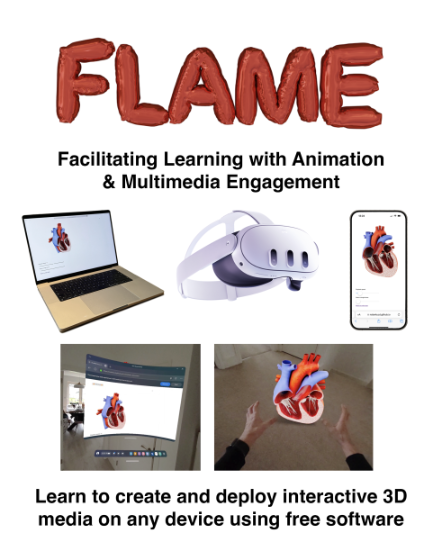FLAME: Facilitating Learning with Animation and Multimedia Engagement
Overview

| PROJECT TITLE: | FLAME: Facilitating Learning with Animation and Multimedia Engagement |
|---|---|
| PROJECT COORDINATOR: | Dr Kevin Nolan, School of Mechanical and Materials Engineering |
| COLLABORATORS: | Professor Lizbeth Goodman, Assoc Professor Vikram Pakrashi, Dr Vincent Hargaden, Dr Ekin Ozer, Dr John Healy, Dr Paul Cuffe, Professor Ronan Cahill, Dr Gerald Barry, Assoc Professor Miguel Bustamante, Assoc Professor Barry Wardell, Marija Grishin, Dr Tine Ningal |
| TARGET AUDIENCE: | Educators and students |
This Learning Enhancement project has been funded through SATLE (Strategic Alignment of Teaching and Learning Enhancement) with the support of the National Forum / HEA.
Background
Many students struggle to visualise complex or abstract concepts encountered in their learning, often in STEM. Frustrated by limited or poor quality materials, they may seek out other sources, including YouTube videos, where high-quality visualisations are presented. However, the quality of the accompanying explanations may be lacking or factually incorrect.
Furthermore, the ability to interact and manipulate objects and concepts in a physical or virtual environment helps learning. Creating such materials is technically challenging. FLAME’s primary driver was to create an environment where educators have an understanding of what the technology is capable of, and if they are unable to create the materials themselves through training, they can articulate to others what they need. This leads to a community of educators curating a digital library of innovative teaching materials. By targeting core concepts that students struggle with universally, the materials developed can be shared across the educational landscape, peer reviewed and updated to ensure pedagogical quality.
A fundamental goal is to minimise technical overhead and make the process as accessible as possible to educators who may have little experience with 3D graphics. Additionally, the materials integrate into existing notes and practices and place no financial or technical burden on students.
Goals
While there is a broad interest in the use of augmented and virtual reality (AR/VR) in teaching, there are considerable hurdles. Firstly, the hardware is expensive and rapidly changing. Secondly, there is little or no availability of teaching materials, and they are complex to create. The FLAME project solves both challenges. We use technologies that allow interaction with 3D objects on any device: smartphone, personal computer, or even VR/AR headsets. The FLAME project developed training materials, workshops and capabilities to enable all educators of any level of experience to create the interactive 3D learning materials that they need to support their teaching. The methods developed have utility across all colleges and disciplines to enhance learning for all.
Key to this was eliminating burdens and barriers. The tools used are open source and easy to use. The learning materials are in addition to existing materials and are easily integrated into UCD’s VLE Brightspace. There is no need to purchase or deploy specialised VR/AR hardware.
Secondly, we aimed to connect digital learning to the campus experience. To this end, a number of physical artefacts were developed to allow students to observe physical phenomena outside the laboratory in a curiosity-driven manner. These provide QR code links to further reading and 3D interactive depictions, allowing the underlying physics to be explored.
Approach
A central strategy to this project was the development of training workshops. These were open to anyone and we had a number of students attending along with second and third level educators. Students were further consulted via focus groups to determine the subjects they felt most needed better support via interactive 3D experiences.
To facilitate the development and delivery of the workshops a digital artist was hired. Their ability to teach concepts in 3D animation to a general audience without a reliance on technical jargon greatly helped ease participants into the topic. A number of PhD students were hired to organise the focus groups and gather student insights.
The materials were deployed in teaching at UCD and student feedback sought to determine the utility of the interactive 3D elements. The goal is to have students lead the demand for specific topics to be included in the Digital Library. A wide range of topics was enumerated. A particular topic that was identified was medical visualisation.
Results
Key deliverables:
- A training workshop to teach the deployment of interactive 3D media.
- Establish the Digital Library for the sharing of created teaching materials.
- Physical artefacts to link online learning to physical touch.
- Establish and disseminate the effectiveness of the produced material to a wider educator audience.
Short-term impacts:
- Training workshops at UCD and the University of Sheffield engaged educators and students. This provided participants with the knowledge and technical skills to implement their 3D media from scratch and provided templates to get them online. Particular guidance we given to implementing this with Brightspace.
- The establishment of the Digital Library provides a foundation to grow a wide range of core learning materials to meet the challenges faced by students. Built on GitHub, it can leverage the collaborative nature of that platform to make additions.
- A conference paper was published at INTED2024 https://library.iated.org/view/HENNELLY2024ELI
- Overwhelmingly positive student feedback has shown the impact of the material in the classroom.
Long-term impacts:
- Planned growth of the digital library into a peer-reviewed digital publication.
- Development of the workshop into a micro-credential.
- Establishment of physical artefacts as artistic installations on campus to support curiosity-driven learning.
Resources
- The Digital Library is available here: https://nolankucd.github.io/FLAME_Library/ and will be continuously updated

- The training materials for the FLAME workshops have been uploaded to the HEA National Forum National Resource Hub. (Currently awaiting moderation).
- The project lead Dr Kevin Nolan can be contacted via email: kevin.nolan@ucd.ie